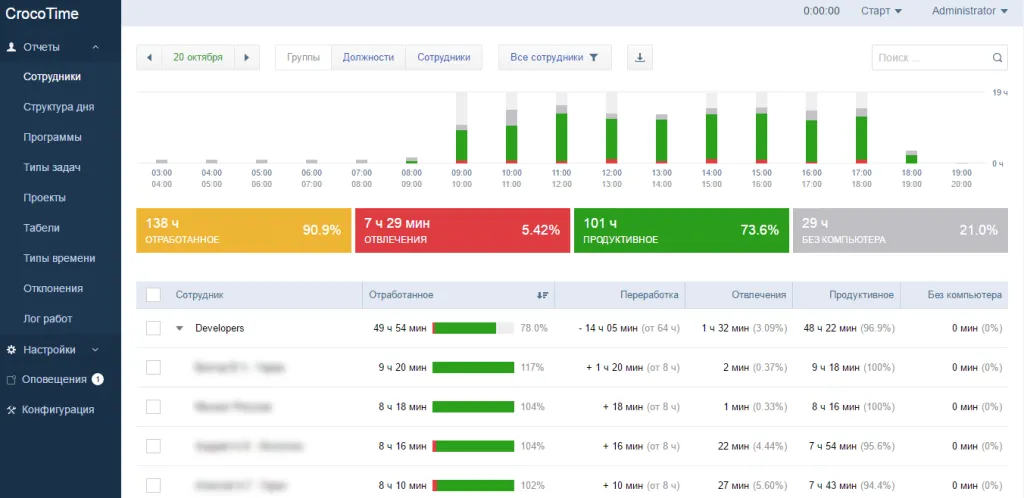
Michael Kalashnikov
September 4, 2023
Employee monitoring practices vary across enterprises. Some managers rely on reports and work results, while others invest in security services and video surveillance. Some opt for automation, preferring GPS trackers and remote CRM systems.
What is the purpose of such monitoring? Does it benefit the company or restrict actions? What happens if employees are not controlled? And how best to automate the process of employee work monitoring? We will answer all these questions in today’s article.
Why control is necessary
Monitoring of employees’ work is necessary not only for the manager or the person responsible for project execution but also for the organization’s employees. In this case, the manager knows that they will receive reliable results, loyalty, and a dependable team. The employees, on the other hand, have opportunities for professional development, growth, and the potential for higher and more stable wages. Additionally, control makes requirements and rules clear to everyone.

The control of employee activities serves to improve various aspects of a company:
-
Clarity of Expectations: It makes key performance indicators (KPIs), responsibilities, and sanctions clear to employees. This clarity leads to more predictable results, fewer task and project failures.
-
Enhanced Trust and Reliability: Clear expectations and well-monitored work lead to trust and reliability in business partnerships and contracts, ensuring that the company meets deadlines.
-
Consistent Quality of Work: Effective monitoring helps maintain a consistent quality of work, making the business competitive and highly regarded in the market.
-
Better Crisis Management: Well-monitored teams are more adept at crisis management, demonstrating efficient management and reliability.
-
Early Problem Identification: Monitoring helps detect problems and errors at the early stages of project execution, which reduces the cost of rectifying deficiencies.
-
Improved Employee Loyalty: The ability to fairly reward employees based on performance enhances their loyalty to the company.
-
Recognition of Success: Monitoring focuses on successes rather than failures, motivating the team and fostering professional and personal development.
Employee monitoring is a mutually beneficial collaboration between two parties that is implemented for the collective good of the organization. It also helps identify dishonest, lazy, and unmotivated employees who are uninterested in their work or career. Detecting such individuals in a timely manner helps reduce theft within the company, identify absenteeism issues, prevent internal espionage, detect fraudsters, and identify weak links among employees.
What Happens If Employees Are Not Controlled Any job, even an interesting and well-paid one, remains an employee’s responsibility and requires significant effort. The lack of control significantly relaxes the team and leads to poor results. Let’s take a closer look at the main problems that arise in the absence of discipline and low levels of control within a company.
Employees Stop Working:
In the absence of real control, most employees gradually start taking the path of least resistance: they complete tasks quickly and with low quality, putting in minimal effort, procrastinating, having tea breaks, and engaging in idle chatter.
Underperforming Employees Go Unnoticed:
Some employees may appear to be working diligently but may have limited abilities and potential. Without regular monitoring, it’s impossible to track which employees are missing deadlines due to a lack of qualifications, skills, or motivation, especially among outsourced team members.
Ineffective Managers Are Also Overlooked:
Some managers may have a high level of knowledge but may not effectively fulfill their responsibilities due to bias towards employees, belittling them, or dismissing valuable employees. Some may withhold valuable information beneficial to the team and the company to receive higher bonuses and to appear better in the eyes of senior management.
Therefore, a well-structured employee work monitoring system is not a whim of employers but a necessity. With monitoring, employees have the opportunity to be objectively evaluated and to independently analyze their contribution to the company’s activities. This increases employee motivation and business productivity.

Types of Employee Monitoring
There are several types of employee activity monitoring, including preliminary, final, and stage-by-stage monitoring.
Preliminary Monitoring:
This type of monitoring should not be applied too frequently, as constant surveillance can be burdensome for employees. However, it can be useful in specific cases, such as when a new employee is undergoing training in the company. In such cases, the manager needs to ensure in a timely manner that the project is progressing in the right direction.
Final Monitoring:
Final monitoring is used to check the ultimate results of an employee’s work when they have already achieved a specific goal or completed a task. This type of monitoring is conducted based on reports of completed work, project completion, a successful outcome in a legal case, or the launch of software.
The advantage of this type of control is that it provides employees with a degree of autonomy, allowing them to feel trusted. This trust encourages employees to take responsibility for task completion and fosters their professional development. At the same time, the manager can save resources, time, and energy and can focus on more critical tasks.
Among the drawbacks of this type of control is the significant risk of missing deadlines or receiving low-quality work, especially for tasks performed by new or inexperienced employees. Therefore, this type of control is suitable primarily for trusted, qualified employees.
Stage-by-Stage Monitoring:
This type of monitoring is used when a task needs to be broken down into specific stages. Stage-by-stage monitoring guides employees not on the processes of their work but on the results. It helps minimize the risk of not achieving the final goal.
How is stage-by-stage employee monitoring applied in work? The administration or manager divides a task into several logical subtasks. For example, data collection, problem analysis, finding solutions, selecting one of them, and then preparing documentation and submitting it to government agencies for registration. After completing each substage and the final stage, the manager conducts a review.
Stage-by-stage monitoring of employee work is best suited for large tasks that require a long time to complete. It is also useful when working with inattentive employees who are process-oriented and require frequent supervision by the manager.

Methods of Employee Monitoring
Certainly, it is essential not to stand behind your colleagues and control their every move closely. This can lead to tension within the team, stress, and even negatively impact department performance, ultimately resulting in negative outcomes. The most effective methods of employee monitoring include:
-
Creating Conditions where Team Members Watch Over Each Other. This involves fostering an atmosphere of mutual vigilance and support within the team. Employees should understand that their colleagues are there to help, not to spy on them. This peer support can help in self-regulation and maintaining discipline.
-
Non-intrusive Monitoring, Conducted Without Direct Supervision. Non-intrusive methods such as monitoring tools and software can help track employee activities without the need for constant physical supervision. These tools can provide valuable data on work habits and productivity.
-
Combining Both Approaches for Maximum Effectiveness. Often, a combination of these approaches, combining peer support with non-intrusive monitoring, can yield the best results. This allows employees to feel trusted and respected while still providing accountability.
How to Organize Employee Monitoring
Effective employee monitoring is organized following the fundamental principles of efficient monitoring. Here are seven such rules:
-
Transparency. Every employee in the company should be aware that their activities are being monitored. They should also know which tools are used for this purpose, what key performance indicators (KPIs) are evaluated, and what consequences await them based on the quality of their work.
-
Predictability. A sense of stability and security is crucial for productive work. The established monitoring system should be clear and not change too frequently. In contrast, constantly changing systems undermine their effectiveness and create confusion.
-
Objectivity. Monitoring rules for employees should be the same for the entire team. Impartiality is the best ally in monitoring. Favoritism has no place in the workplace.
-
Subtlety. Staying informed about all activities and interfering in every project are two entirely different and incompatible processes. A supervisor should only act according to a pre-approved plan unless there is an urgent situation.
-
Consistency. A well-established system is a regular system. If management starts monitoring subordinates, they should do it consistently, without interruption, and not weaken their observations.
-
Effectiveness. Administrative staff, managers, and other top executives responsible for monitoring employees should not devote all their time to monitoring others. Otherwise, they will simply not have time to perform their own tasks, which will affect overall productivity.
-
Results. Monitoring for the sake of monitoring achieves nothing. It’s essential to understand what to do with the results of the monitoring: identify effective employees or problem areas, plan further actions, harness potential, or rectify shortcomings.
Mistakes to Avoid
No matter how much a manager strives to increase productivity and improve employee performance, they can always encounter adverse effects. Common mistakes made by administrative teams include:
-
Unsystematic monitoring: Identifying work deficiencies without acknowledging team achievements or successes.
-
Monitoring without understanding: When a manager lacks understanding and insight into the work performed by employees.
-
Formal monitoring: Leading to equally formal actions by employees.
Additionally, unethical methods of monitoring, such as eavesdropping on phone calls, reading messages, excessive video surveillance, or spying on employees through webcams, should be avoided. Employee monitoring should be conducted legally, correctly, and systematically, without overstepping ethical boundaries. In this case, employees will not fear punishment or termination but will strive for high performance and productivity, making employee monitoring an obvious asset.
3 Systems for Employee Work Monitoring
One of the key factors in successful personnel management is the automation of work monitoring. This has become possible with modern remote programs, online services, time tracking systems, and specialized CRM systems. These solutions effectively ensure productivity, employee accountability, and compliance with company rules.
From the multitude of top products available on the market, we have selected the most reliable and user-friendly services that allow for quality tracking of employee activities, particularly in remote work conditions. Carefully read the overview, familiarize yourself with the features and options, and consider which program suits your business best.
1. LeaderTask
This unique assistant helps teams and individual employees plan tasks and activities, include important tasks in their daily schedules, monitor assignments, and quickly achieve their goals. The program enables efficient time management, making the company more productive.
It’s ideal for teamwork and supervising subordinates. Its tools easily distribute and delegate tasks, create projects, and customize individual or collaborative experiences for task execution and control of processes.
Features:
-
Ability to create an endless list of tasks and subtasks, checklists, and projects with color-coded labels from a standard set or custom settings.
-
Task automation, history, sorting, and filtering.
-
Individual task access, “God mode” for viewing team members’ tasks, team roles.
-
Kanban boards, goal visualization, plan and schedule creation.
-
Client database, creation of request forms in the builder, incoming request processing.
-
Ability to assign and reassign tasks, control, make adjustments, and send tasks for revision.
-
Employee productivity scale and task completion schedule.
-
Ability to attach any attachments (photos, images, documents, links, archives).
-
Built-in calendar, daily planner, schedule, “smart” notifications, reminders.
-
“Focus” feature for concentrating on top-priority tasks.
-
Intelligent search, customization of settings.
-
Browser widgets, task creation from email.
-
Offline mode and synchronization.
MegaPlan
A CRM system is suitable for personnel management in any business sphere: sales, construction, services, manufacturing, and more. It successfully increases the company’s productivity and saves time for both management and employees through data analysis and organization.
Employees, whether working in the office or remotely, interact with the program by uploading their work results. Managers can review ready-made reports thanks to the software’s analysis based on selected metrics. Additionally, there is a feedback function from department or company management.
Tools:
-
Unified customer database, manager control, interaction history, sales funnel.
-
Task assignment, deadline monitoring, notifications, timing tracking, analytics.
-
Calendar, discussions, vacation schedule.
-
Data input automation.
-
Integration with WhatsApp and other third-party services.
-
Document templates, automated tasks, deal scenarios.
-
High-level security.
-
Quick implementation.
-
Mobile applications available on the App Store and Google Play.
Crocotime

A program that automatically tracks working hours on the computer, meetings, and calls. It helps managers monitor the activities of their employees on their computers, their locations, what they used, and which programs they worked with. Additionally, applications can be marked as either efficient or inefficient.
Tools:
-
Computer activity monitoring.
-
Photos of the workday.
-
Automatic timesheets.
-
Business process analytics, consulting services.
-
Integrations with telephony, corporate calendars, turnstiles, and HR systems.
-
Stable technical support and system updates.
-
Flexible software customization for specific companies and business sectors.
-
Cloud and local versions of the service.
Pricing:
-
Cloud-based: 2,59 $ per user per month.
-
Local: Calculated individually, depending on the number of employees and the company’s size.
-
Free trial period for the cloud-based version: 2 weeks.
Conclusion
Don’t forget that before purchasing software, it’s necessary to test it. Services typically offer either a trial period of 7 to 30 days or a free version with limited functionality.
This way, you won’t make a mistake and will make the right choice. The service will allow you to effectively monitor employees, increase work productivity, and improve sales performance for products or services. Good luck!









